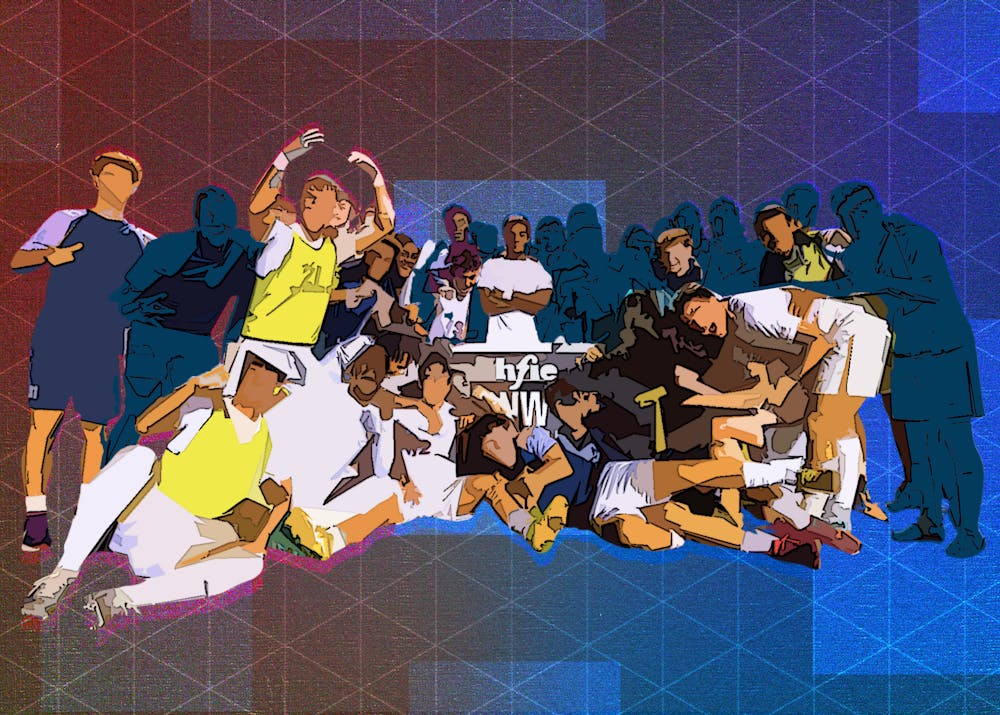The men’s soccer bench this year looks sparsely populated. There are a lot less players smushed together, competing for tush space on the metal strip.
There is no more crowd of substitutes warming up, no more clump of sneakered reserves standing next to the bench, left off the gameday squad because the game roster is too small to accommodate them.
The overcrowding of past seasons is no longer. Virginia’s men’s soccer team is not trying anymore to wedge the equivalent of two full rosters onto the bench of one.
It can’t.
Roster limits, dressed in the livery of the House v. NCAA settlement, have arrived. The settlement enshrined them across college sports in June, after years of anticipation and an offseason of preparation. Each sport, instead of the scholarship limit that existed before, now has unlimited scholarships and a cap on its roster size.
The NCAA previously fixed the amount of scholarships a team could distribute, based on the sport. But a team’s roster could stretch as large as it decided. Under the recent settlement, the governing body decided on the amount of players per sport a team can carry, and it can give out as many scholarships as it decides.
Virginia men’s soccer’s roster size hovered around the three-dozen mark for a while — 36 three years ago, 36 two years ago, 42 last season. This go-around, Virginia is carrying 30 players.
Looking back, after the season-opener Aug. 21, at the swollen rosters of years past, Coach George Gelnovatch marveled at the contrast. His staff can coach that much more efficiently having shed 12 players.
“The bandwidth that 40 guys on a roster takes up,” Gelnovatch said. “I wasn’t even aware of it until now.”
Gelnovatch is just one of a handful of Virginia’s fall-sport coaches navigating the impact of the newfound roster limits in the first few weeks of their seasons. But most described a far less staggering experience than the men’s soccer skipper.
Not every program’s roster, in the first place, actually contained more players than the new limits allow. They have barely been affected. You cannot bump your head on the ceiling if you are too short.
Coach Shannon Wells’s volleyball program, for example, has always operated under the 18-player limit just applied to the sport. Coach Andres Pedroso’s men’s tennis program has flirted over the years with the new line of 10 players but will have no trouble remaining under it.
The same goes for Coach Steve Swanson and women’s soccer. While the program’s roster, like others across the country, overflowed for a few years because of pandemic-generated extra eligibility, its numbers receded last season. Swanson noted no consternation over the limits because the number they impose is roughly standard for his team.
But the limits are something, at least, that will inhabit the back of his and any coach’s mind going forward. The number will need to be considered in recruiting, in planning for the future.
“You can only have 28 on your team,” Swanson said. “You have to be aware of that.”
This season, in fact, his team, like Gelnovatch’s, has two more than soccer’s 28-player limit. That is because the settlement, when its initial language hit the concentric circles of college sports discourse, provoked quite a stir. It would mean so many players losing their roster spots.
So the lawyers came up with a solution, to “grandfather in” players, to make sure nobody would have to lose their roster spot. Any athlete who had, or had been promised, a roster spot that they would lose as a result of the settlement could be named a “designated student-athlete” and maintain their spot. Swanson liked the tweak.
“I thought that was good, especially for the current players,” Swanson said.
Coach Tony Elliott agrees, even more fervently. This year he has 124 players, boosted by a whole squadron of designated student-athletes. That will eventually shrink to 105.
“I’m thankful that they didn’t go right to 105 right away,” Elliott said. “It allowed us to be able to carry enough depth to practice the way that we need to.”
Over the next few years the team’s size will dwindle as the grandfathered players graduate, and, Elliott said, it is going to make quite an impact. That is a muddy prospect.
“You won’t have the ability to tackle as much as you did,” Elliott said. “It’s going to be harder to truly get the reps that you need for the truly developmental guys, because you’re going to have to modify the way that you practice.”
It also might impact early-season games, he said. Injuries later on in the season could force teams to rethink how they use their players throughout the week.
It is all to be seen. But the men’s soccer team, for one, is already seeing the effects of a reduced roster.
The program did not need to drop any of last season’s players. But it ended up, despite the “grandfathering,” with a much smaller roster. Of last season’s 42 players, 11 transferred to other schools.
But the team, at any rate, is doing better with the tighter roster. In college soccer’s compressed preseason, two weeks wadded tighter than a clump of torn earth, the change leaves quite an impact.
Fusing roughly 40 guys into a team in that period was always a chore. Now subtract 10.
“That’s 25 percent less,” Gelnovatch said. “It’s allowing us to manage, coach a little better. It’s made a big difference.”
Thomas Baxter, Victoria Blankenship, Eleanor Buchanan, Sam Chun and Xander Tilock contributed reporting.







